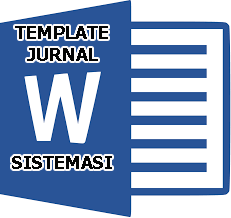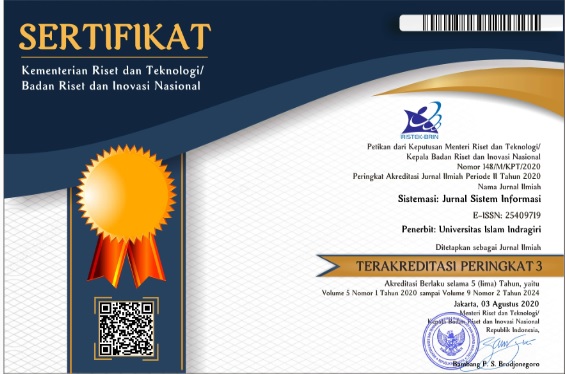Implementation of Deep Transfer Learning and Explainable AI in Skin Cancer Classification
Abstract
Keywords
Full Text:
PDFReferences
M. N. Alnuaimi et al., “Transfer Learning Empowered Skin Diseases Detection in Children,” CMES - Computer Modeling in Engineering and Sciences, Vol. 141, No. 3, pp. 2609–2623, 2024, doi: 10.32604/cmes.2024.055303.
S. Gondhowiardjo et al., “Five-Year Cancer Epidemiology at the National Referral Hospital: Hospital-based Cancer Registry Data in Indonesia,” JCO Global Oncol, Vol. 7, pp. 190–203, 2021, doi: 10.1200/GO.20.
Y. L. Vechtomova, T. A. Telegina, A. A. Buglak, and M. S. Kritsky, “UV Radiation in dna Damage and Repair Involving Dna-Photolyases and Cryptochromes,” Nov. 01, 2021, MDPI. doi: 10.3390/biomedicines9111564.
R. Dandu, M. Vinayaka Murthy, and Y. B. Ravi Kumar, “Transfer learning for segmentation with hybrid classification to Detect Melanoma Skin Cancer,” Heliyon, Vol. 9, No. 4, Apr. 2023, doi: 10.1016/j.heliyon.2023.e15416.
D. Aharwal, R. Changulani, A. Pathak, and D. Shukla, “Psychiatric Morbidity among Dermatological Patients Attending a Tertiary Care Hospital in Central India,” National Journal of Community Medicine, Vol. 14, No. 7, pp. 440–445, Jul. 2023, doi: 10.55489/njcm.140720232918.
R. Shreberk-Hassidim, S. M. Ostrowski, and D. E. Fisher, “The Complex Interplay between Nevi and Melanoma: Risk Factors and Precursors,” Feb. 01, 2023, Multidisciplinary Digital Publishing Institute (MDPI). doi: 10.3390/ijms24043541.
P. Spyridonos, G. Gaitanis, A. Likas, and I. Bassukas, “Characterizing malignant melanoma clinically resembling seborrheic keratosis using deep knowledge transfer,” Cancers (Basel), Vol. 13, No. 24, Dec. 2021, doi: 10.3390/cancers13246300.
Y. Zhang, Y. Weng, and J. Lund, “Applications of Explainable Artificial Intelligence in Diagnosis and Surgery,” Feb. 01, 2022, Multidisciplinary Digital Publishing Institute (MDPI). doi: 10.3390/diagnostics12020237.
D. F. Santos-Bustos, B. M. Nguyen, and H. E. Espitia, “Towards Automated Eye Cancer Classification via VGG and ResNet Networks Using Transfer Learning,” Engineering Science and Technology, an International Journal, Vol. 35, Nov. 2022, doi: 10.1016/j.jestch.2022.101214.
A. T. Ibrahim, M. Abdullahi, A. F. Donfack Kana, M. T. Mohammed, and I. H. Hassan, “Categorical Classification of Skin Cancer using a Weighted Ensemble of Transfer Learning with Test Time Augmentation,” Data Science and Management, Nov. 2024, doi: 10.1016/j.dsm.2024.10.002.
R. O. Ogundokun et al., “Enhancing Skin Cancer Detection and Classification in Dermoscopic Images through Concatenated MobileNetV2 and Xception Models,” Bioengineering, Vol. 10, No. 8, Aug. 2023, doi: 10.3390/bioengineering10080979.
O. E. Adebayo, B. Chatelain, D. Trucu, and R. Eftimie, “Deep Learning Approaches for the Classification of Keloid Images in the Context of Malignant and Benign Skin Disorders,” Diagnostics, Vol. 15, No. 6, Mar. 2025, doi: 10.3390/diagnostics15060710.
P. N. Hai, N. C. Thanh, N. T. Trung, and T. T. Kien, “Transfer Learning for Disease Diagnosis from Myocardial Perfusion SPECT Imaging,” Computers, Materials and Continua, Vol. 73, No. 3, pp. 5925–5941, 2022, doi: 10.32604/cmc.2022.031027.
K. M. Adnan et al., “Deep Learning Driven Interpretable and Informed Decision Making Model for Brain Tumour Prediction using Explainable AI,” Sci Rep, Vol. 15, No. 1, Dec. 2025, doi: 10.1038/s41598-025-03358-0.
S. Alkhalaf et al., “Adaptive Aquila Optimizer with Explainable Artificial Intelligence-Enabled Cancer Diagnosis on Medical Imaging,” Cancers (Basel), Vol. 15, No. 5, Mar. 2023, doi: 10.3390/cancers15051492.
A. Gramegna and P. Giudici, “SHAP and LIME: An Evaluation of Discriminative Power in Credit Risk,” Front Artif Intell, Vol. 4, 2021, doi: 10.3389/frai.2021.752558.
S. Khiat, S. A. Mahmoudi, S. Stassin, L. Boukerroui, B. Senaï, and S. Mahmoudi, “An Efficient Explainability of Deep Models on Medical Images,” Algorithms, Vol. 18, No. 4, Apr. 2025, doi: 10.3390/a18040210.
S. Jain, U. Singhania, B. Tripathy, E. A. Nasr, M. K. Aboudaif, and A. K. Kamrani, “Deep Learning-based Transfer Learning for Classification of Skin Cancer,” Sensors, Vol. 21, No. 23, Dec. 2021, doi: 10.3390/s21238142.
M. Mateen, S. Hayat, F. Arshad, Y. H. Gu, and M. A. Al-antari, “Hybrid Deep Learning Framework for Melanoma Diagnosis Using Dermoscopic Medical Images,” Diagnostics, Vol. 14, No. 19, Oct. 2024, doi: 10.3390/diagnostics14192242.
S. M. Thwin and H. S. Park, “Skin Lesion Classification using a Deep Ensemble Model,” Applied Sciences (Switzerland), Vol. 14, No. 13, Jul. 2024, doi: 10.3390/app14135599.
A. Alrabai, A. Echtioui, and F. Kallel, “Exploring Pre-Trained Models for Skin Cancer Classification,” Applied System Innovation, Vol. 8, No. 2, Apr. 2025, doi: 10.3390/asi8020035.
M. A. Khan et al., “COVID-19 Classification from Chest X-Ray Images: A Framework of Deep Explainable Artificial Intelligence,” Comput Intell Neurosci, Vol. 2022, 2022, doi: 10.1155/2022/4254631.
Luqman Hakim, Z. Sari, and H. Handhajani, “Klasifikasi Citra Pigmen Kanker Kulit Menggunakan Convolutional Neural Network,” Jurnal RESTI (Rekayasa Sistem dan Teknologi Informasi), Vol. 5, No. 2, pp. 379–385, Apr. 2021, doi: 10.29207/resti.v5i2.3001.
K. Maharana, S. Mondal, and B. Nemade, “A review: Data pre-Processing and Data Augmentation Techniques,” Global Transitions Proceedings, Vol. 3, No. 1, pp. 91–99, Jun. 2022, doi: 10.1016/j.gltp.2022.04.020.
Y. Shu, J. Zhang, Y. Wang, and Y. Wei, “Fruit Freshness Classification and Detection Based on the ResNet-101 Network and Non-Local Attention Mechanism,” Foods, Vol. 14, no. 11, p. 1987, Jun. 2025, doi: 10.3390/foods14111987.
DOI: https://doi.org/10.32520/stmsi.v14i5.5425
Article Metrics
Abstract view : 1000 timesPDF - 169 times
Refbacks
- There are currently no refbacks.

This work is licensed under a Creative Commons Attribution-ShareAlike 4.0 International License.









